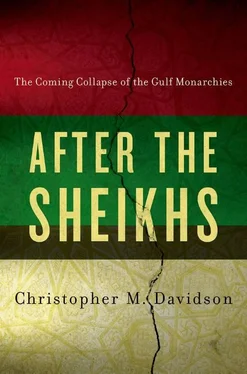Affecting all six Gulf monarchies are their declining hydrocarbon reserves and rising patterns of domestic energy consumption, coupled with their rapidly increasing indigenous populations — most of which are now under the age of twenty-one. This is already placing great strain on these states’ ability to keep fulfilling their citizens’ economic expectations, while their welfare states and distributive systems are also feeling the strain, even in the wealthier Gulf monarchies, due to the costs of perpetually subsidising their populations. Connected to this has been the structural problem of ‘voluntary unemployment’: despite frequent labour nationalisation initiatives, most Gulf monarchies remain unable to motivate their citizens to gain meaningful employment and contribute to the national economy given their reliance on state welfare and expectation of automatically remaining members of a wealthy national elite, courtesy of their citizenship. Exacerbated by the lack of transparency in these monarchies, other pressures on their increasingly limited national resources include the ongoing financing of prestige projects, the squandering of government spending, and the accumulation of vast wealth by the ruling families and their closest allies.
Already apparent in the poorer Gulf monarchies has been the increase in poverty among citizens, with real unemployment increasing as states can offer no longer the same kind of economic opportunities as in the past. This is leading to stark wealth gaps emerging between the wealthiest and poorest families in some of the national populations, which in turn is undermining any sense of equality between them and thus jeopardising the tribal heritage and religious legitimacy resources that the rulers have previously enjoyed. Widespread, and in many ways state-sanctioned, discrimination against large sections of the Gulf monarchies’ national populations is also on the increase — again undermining the ruling families’ credentials — with hundreds of thousands of stateless persons now probably further away from being naturalised than ever before, and with substantial indigenous Shia populations — especially in Bahrain and Saudi Arabia — now firmly relegated to second class citizenship. Of equally great concern, and similarly weakening the ruling families’ ability to uphold their social contracts and maintain legitimacy, has been the reliance on increasingly repressive forms of censorship — in some cases long before 2011. Affecting citizens and expatriates alike, this has choked off most remaining channels of expression and discontent, and is thus making it much harder for the Gulf monarchies to keep disguising the authoritarian nature of their polities.
Resources, populations, and subsidies
Although some Gulf monarchies still command substantial hydrocarbon resources, even these will face pressure to maintain the same level of subsidies for their populations in the coming years, especially as reserves rapidly deplete and meaningful diversification of their economic bases remains limited. Meanwhile, those monarchies that are already suffering from severely depleted reserves are now failing to maintain certain subsidies. Given the obvious political ramifications of declining benefits and any cutbacks to their welfare states, the Gulf monarchies have been understandably sensitive and often secretive with regards to their remaining resources. According to US diplomatic cables despatched between 2007 and 2009 it was claimed, for example, that Saudi Arabia may have been overstating its crude oil reserves by as much as 300 billion barrels — or 40 per cent. Quoting a senior geologist, the cables disagreed with Saudi Aramco’s senior vice president for exploration, who claimed in 2007 that Aramco had 716 billion barrels of total reserves, of which 51 per cent were recoverable, and that in twenty years Aramco would have 900 billion barrels of reserves. Instead it was argued that Saudi Arabia will soon reach a plateau in total output that will last only fifteen years before beginning to decline. [462] 1. Wikileaks, US Embassy Riyadh, 10 December 2007.
Importantly, cables from 2009 also noted that Saudi Arabia’s ability to export oil (and thus keep financing the welfare state and providing subsidies) will decline as its domestic energy demands rapidly increase. The cables stated that ‘…demand [for electricity] is expected to grow 10 per cent a year over the next decade as a result of population and economic growth… as a result [Saudi Arabia] will need to double its generation capacity to 68,000MW in 2018’, while also claiming that various major project delays and accidents in Saudi Arabia are ‘evidence that Saudi Aramco is having to run harder to stay in place — to replace the decline in existing production’. [463] 2. Wikileaks, US Embassy Riyadh, 23 November 2009.
In the weakest position has been Bahrain, where as early as 1965 half of its onshore oil reserves were already thought to have been depleted and in 1987 production from its offshore Abu Safah field (shared with Saudi Arabia) began to slow. Since then Bahrain has had to rely heavily on about 147,000 barrels per day (about 77 per cent of its total output) from Saudi Arabia, [464] 3. Kinninmont, Jane, Bahrain: Beyond the Impasse (London: Chatham House, 2012), p. 2.
as compensation for this loss. In 1993 Bahrain’s remaining reserves were estimated at just 200 million barrels with total depletion expected in 2005. [465] 4. See Metz, Helen (ed.), Persian Gulf States: A Country Study (Washington: GPO for the Library of Congress, 1993).
Although this may have taken place, it has been somewhat disguised by Bahrain’s oil-refining capacity, which now primarily refines Saudi oil. As with many other Gulf monarchies, Bahrain is now a prominent gas producer, but again it is estimated that an increasing proportion of its output will be required by the domestic sector.
Similarly Oman is believed to have shrinking oil output, [466] 5. AME Info, 7 February 2008.
with recent discoveries having either proved commercially unviable or on a much smaller scale than in the past. [467] 6. See Metz (1993).
In total it is thought to have only 5.5 billion barrels of oil in known reserves — most of which are spread out over disparate fields. This means Oman will soon become a net hydrocarbon importer [468] 7. CIA World Factbook, 2011, country overview on Oman.
as its domestic energy consumption has more than doubled over the past decade. [469] 8. US Energy Information Administration 2011. Country overview on Oman.
While Abu Dhabi still has a few decades of oil reserves remaining — with an estimated 98 billion barrels of oil left, [470] 9. US Energy Information Administration 2011. Country overview on the UAE.
its gas production is hampered by high sulphur rates and is increasingly being earmarked for the domestic sector. Abu Dhabi is already importing Qatari gas via the Dolphin pipeline — a joint project with Qatar and Royal Dutch Shell originally conceived in 1999. But most problematic for Abu Dhabi is the increasing amount of energy it has to supply to the six other UAE emirates as their demands also increase. Although the poorest four emirates have never had significant hydrocarbon reserves, both Dubai and Sharjah were once oil and gas producers. Sharjah’s production is now minimal, and in 1995 Dubai’s daily oil output slowed to just 300,000 barrels. [471] 10. By 1995 production had dropped to around 300,000 barrels per day.
Although the ruler of Dubai made an announcement in early 2010 that a new offshore oilfield had been discovered, [472] 11. The Daily Telegraph , 4 February 2010.
this seemed to be primarily a political move as the emirate was trying to restore investor confidence following the difficulties it faced in late 2009. Indeed, analysts quickly expressed doubts over the commercial viability of the field and described the find as ‘a drop in [Dubai’s] ocean of debt’. [473] 12. Agence France Presse, 9 February 2010.
Читать дальше












